转载请把头部出处链接和尾部二维码一起转载,本文出自逆流的鱼yuiop:http://blog.csdn.net/hejjunlin/article/details/52738492
前言:国庆节告一段落,又是新一月,上月主要是围绕MediaPlayer相关展开,从今天开始,开始分析多媒体框架中的Camera模块,看下今天的Agenda:
- Camera拍照
- Camera录像
- 新API android.hardware.camera2
- 新旧API特点对比
- Camera自定义相机
- 新API android.hardware.camera2自定义相机
Camera类被用于获取图片设置,start/stop 预览,快照图片,恢复视频编码的帧,Camera是一个client对于Camera Service来说,将管理Camera 硬件相关, 为了使用设备的camera, 须要在Manifest中加上相应的权限,如你须要自动聚焦功能,在Manifest.xml须加入
<uses-permission android:name="android.permission.CAMERA" /> <uses-feature android:name="android.hardware.camera" /> <uses-feature android:name="android.hardware.camera.autofocus" />Camera拍照
用Camera去拍照,将遵循以下几个步骤:
- 获得一个Camera的实例,通过open方法
- 如果必要的话,可以修改一些默认参数
- 通过初始化SurfaceHolder去setPreviewDisplay(SurfaceHolder),没有Surface, camera不能开始预览
- 调用startPreview方法开始更新预览的surface,在拍照前,预览(preview)必须被开启。
- 当你想开始拍照时,使用takePicture(Camera.ShutterCallback, Camera.PictureCallback, Camera.PictureCallback, Camera.PictureCallback), 等待回调提供真实的图像数据
- 当拍完一张照片时,预览(preview)将会停止,当你想要拍更多的照片时,须要再一次调用startPreview方法
- 当调用stopPreview方法时,将停止更新预览的surface
- 当调用release方法时,将马上释放camera
以上是拍照过程,当如果切换成视频录制模式时,将遵循以下步骤:
- 获取一个初始化Camera,且开始预览
- 调用unlock方法允许media进程去访问camera
- 通过camera去setCamera(Camera),了解更多,可看MediaRecorder
- 当完成录制时,调用reconnect方法重新获取且重新lock camera
- 调用stopPreview()方法且release方法时,作为以上描述
- 这个类是一个非线程安全类,意味着在被使用任何工作线程中,大多数长运行操作(preview,focus,photo capture 等)发生,异步调用回调是必要的。回调被调用在事件线程,Camera方法决不能一次被多个线程调用
- 不同的安卓设备可能有不同的硬件规格,如像素的评级和自动对焦功能。
从API-21(5.0)开始,新增一个android.hardware.camera2包,取代原来Camera.java。
Android平台支持拍照及录制视频,通过android.hardware.camera2相关API或camera Intent,下面是一些相关联的类
- android.hardware.camera2 主要的API控制相机设备,被用于拍照及拍视频当build一个camera应用时
- Camera Android 5.0之前控制相机设备的class
- SurfaceView 呈现实时预览给用户
- MediaRecorder 用户录制视频
- Intent Intent action类型:MediaStore.ACTION_IMAGE_CAPTURE/MediaStore.ACTION_VIDEO_CAPTURE,拍照或录视频,不用直接用Camera(可通过调起第三方定义的Camera)
本文出自逆流的鱼yuiop:http://blog.csdn.net/hejjunlin/article/details/52738492
新旧API特点对比android.hardware.camera2与原来的camera API相比,不同之处在于:
- 原生支持RAW照片输出突发拍摄模式
- 制约拍照速度的不再是软件而是硬件。以Nexus 5为例,分辨率全开下Andorid L的连拍速度可达到30fps。
- 全自动控制快门、感光度、对焦、测光、硬件视频防抖等多种参数都被整合到了新的API内。
- 新的API中添加的手动控制功能列表:感光度手动对焦/AF开关AE/AF/AWB模式AE/AWB锁硬件视频防抖连续帧
- 可以用单个手指进行缩放
- 支持QR码识别
使用Camera有两种方式:通过Intent使用已有的app和通过Camera构建自己的app。通过Camera API的方式拍照。
通过Camera API方式拍照需要引入几个关键的类:
-
Camera类:最主要的类,用于管理Camera设备,本文中主要用到以下方法:
- open():通过open方法获取Camera实例。
- setPreviewDisplay(SurfaceHolder):设置预览拍照
- startPreview():开始预览
- stopPreview():停止预览
- release():释放Camera实例
- takePicture(Camera.ShutterCallback shutter, Camera.PictureCallback raw, Camera.PictureCallback jpeg):这个是拍照要执行的方法,包含了三个回调参数。Shutter是快门按下时的回调,raw是获取拍照原始数据的回调,jpeg是获取经过压缩成jpg格式的图像数据。在本文中需要实现最后一个回调,参见下面。
- Camera.PictureCallback接口:该回调接口包含了一个onPictureTaken(byte[]data, Camera camera)方法。在这个方法中可以保存图像数据。
-
SurfaceView类:用于控制预览界面
-
SurfaceHolder.Callback接口:用于处理预览的事件,需实现如下三个方法:
- surfaceCreated(SurfaceHolderholder):预览界面创建时调用,每次界面改变后都会重新创建,需要获取相机资源并设置SurfaceHolder。
- surfaceChanged(SurfaceHolderholder, int format, int width, int height):预览界面发生变化时调用,每次界面发生变化之后需要重新启动预览。
- surfaceDestroyed(SurfaceHolderholder):预览销毁时调用,停止预览,释放相应资源。
通过Camera方式来实现拍照
通过Camera方式 会比通过Intent方式获得更为丰富的功能。通常创建一个定制化的Camera需要如下步骤:
(1) 通过Camera.open()来获取Camera实例。 (2) 创建Preview类,需要继承SurfaceView类并实现SurfaceHolder.Callback接口。 (3) 为相机设置Preview (4) 构建一个Preview的Layout来预览相机; (5) 为拍照建立Listener以获取拍照后的回调; (6) 拍照并保存文件; (7) 释放Camera。
本文出自逆流的鱼yuiop:http://blog.csdn.net/hejjunlin/article/details/52738492
Camera自定义相机
CameraSample代码如下:
MainActivity.java
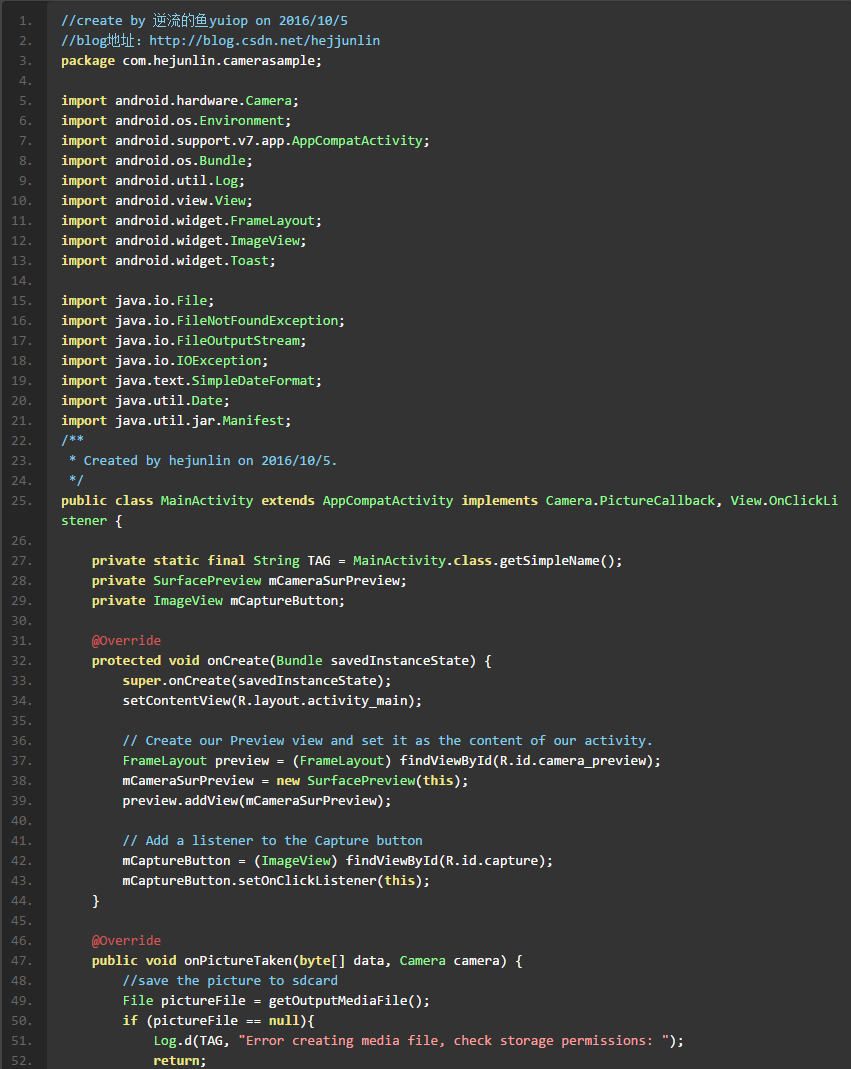
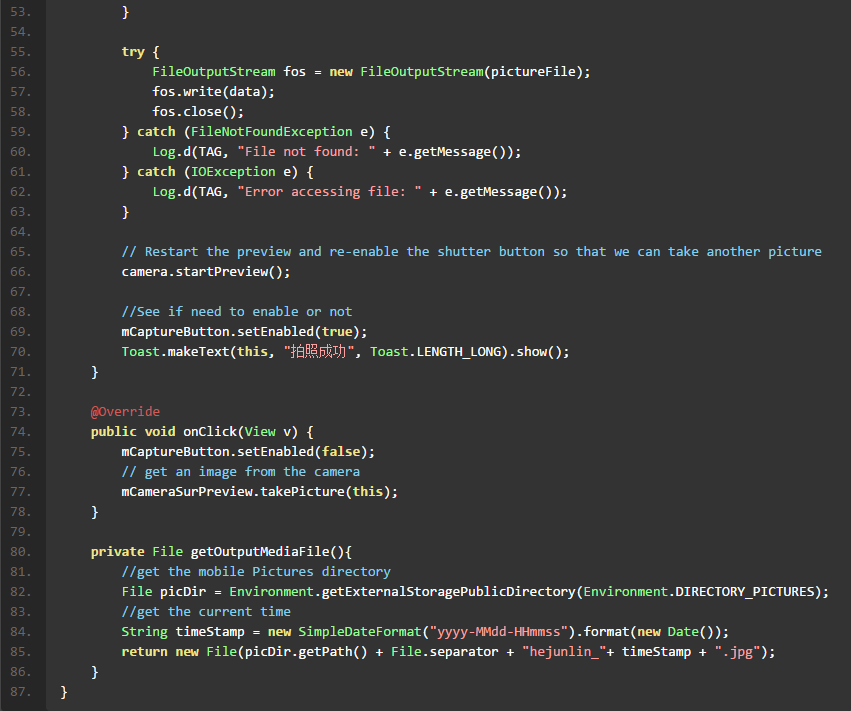
SurfacePreview.java
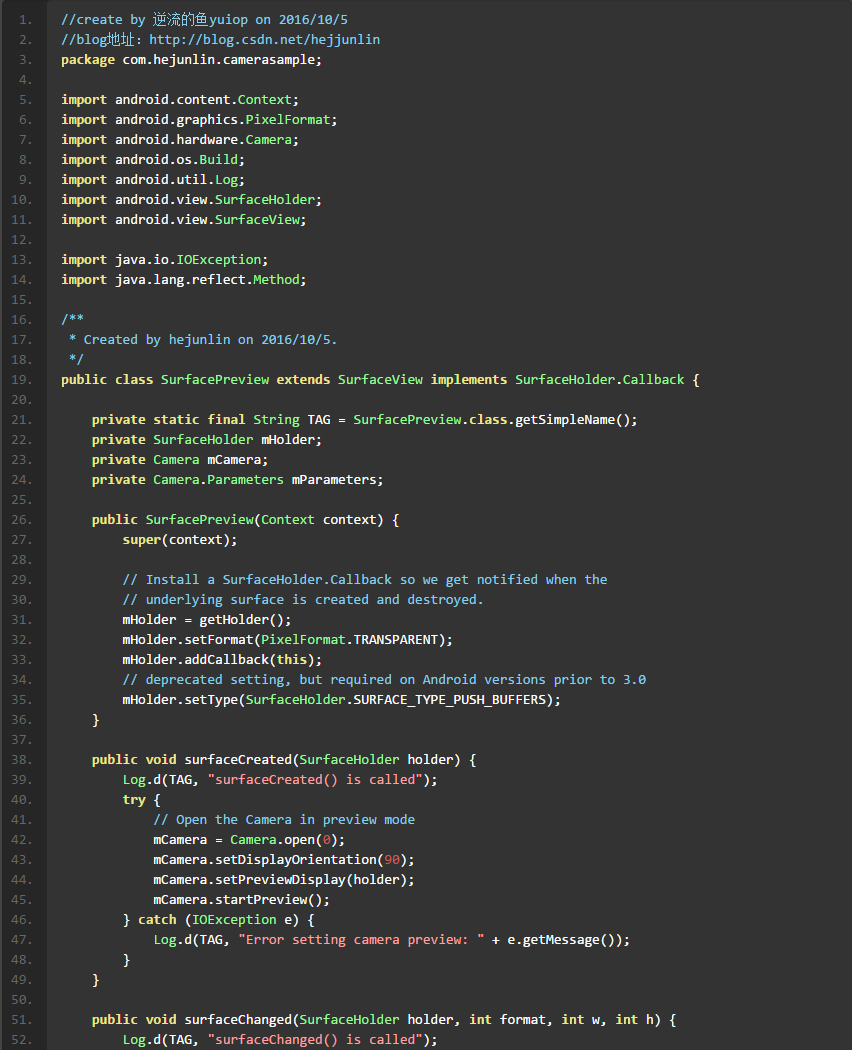
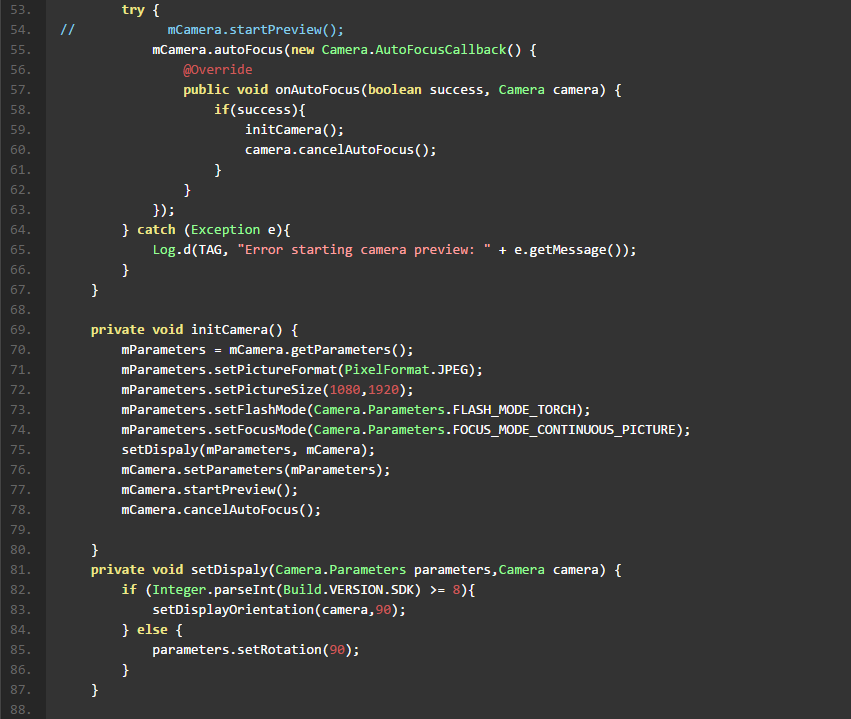
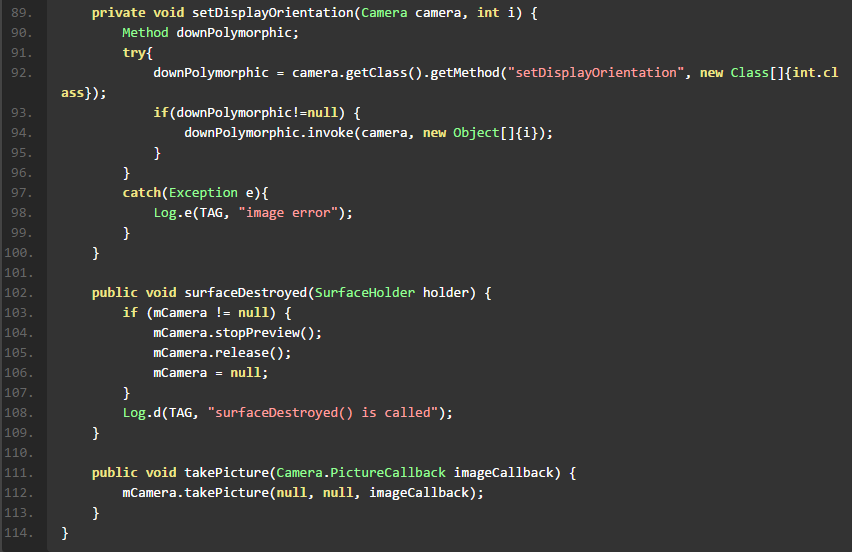
activity_main.xml
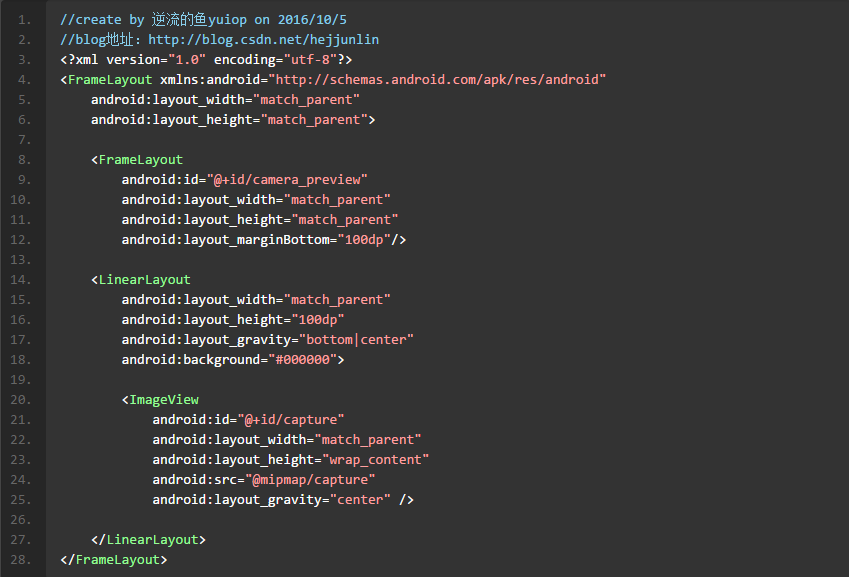
效果图:
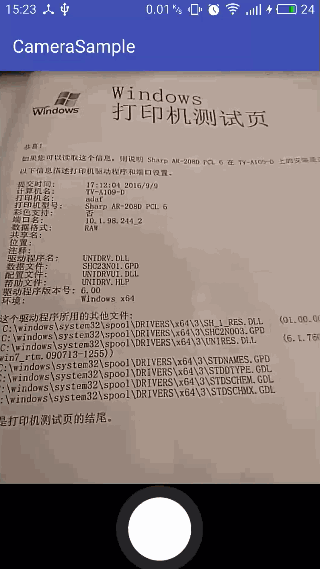 本文出自逆流的鱼yuiop: http://blog.csdn.net/hejjunlin/article/details/52738492
新API android.hardware.camera2自定义相机
本文出自逆流的鱼yuiop: http://blog.csdn.net/hejjunlin/article/details/52738492
新API android.hardware.camera2自定义相机
接下来看来用新API自定义相机: MainActivity.java
package com.hejunlin.camerasample2; import android.support.v7.app.AppCompatActivity; import android.os.Bundle; public class MainActivity extends AppCompatActivity { @Override protected void onCreate(Bundle savedInstanceState) { super.onCreate(savedInstanceState);
setContentView(R.layout.activity_main); if (null == savedInstanceState) {
getFragmentManager().beginTransaction()
.replace(R.id.container, Camera2Fragment.newInstance())
.commit();
}
}
}
Camera2Fragment.java
package com.hejunlin.camerasample2; import android.Manifest; import android.app.Activity; import android.app.AlertDialog; import android.app.Dialog; import android.app.DialogFragment; import android.app.Fragment; import android.content.Context; import android.content.DialogInterface; import android.content.pm.PackageManager; import android.content.res.Configuration; import android.graphics.ImageFormat; import android.graphics.Matrix; import android.graphics.Point; import android.graphics.RectF; import android.graphics.SurfaceTexture; import android.hardware.camera2.CameraAccessException; import android.hardware.camera2.CameraCaptureSession; import android.hardware.camera2.CameraCharacteristics; import android.hardware.camera2.CameraDevice; import android.hardware.camera2.CameraManager; import android.hardware.camera2.CameraMetadata; import android.hardware.camera2.CaptureRequest; import android.hardware.camera2.CaptureResult; import android.hardware.camera2.TotalCaptureResult; import android.hardware.camera2.params.StreamConfigurationMap; import android.media.Image; import android.media.ImageReader; import android.os.Bundle; import android.os.Environment; import android.os.Handler; import android.os.HandlerThread; import android.support.annotation.NonNull; import android.support.v13.app.FragmentCompat; import android.support.v4.content.ContextCompat; import android.util.Log; import android.util.Size; import android.util.SparseIntArray; import android.view.LayoutInflater; import android.view.Surface; import android.view.TextureView; import android.view.View; import android.view.ViewGroup; import android.widget.Toast; import java.io.File; import java.io.FileNotFoundException; import java.io.FileOutputStream; import java.io.IOException; import java.nio.ByteBuffer; import java.text.SimpleDateFormat; import java.util.ArrayList; import java.util.Arrays; import java.util.Collections; import java.util.Comparator; import java.util.Date; import java.util.List; import java.util.concurrent.Semaphore; import java.util.concurrent.TimeUnit; public class Camera2Fragment extends Fragment implements View.OnClickListener, FragmentCompat.OnRequestPermissionsResultCallback { /**
* Conversion from screen rotation to JPEG orientation.
*/ private static final SparseIntArray ORIENTATIONS = new SparseIntArray(); private static final int REQUEST_CAMERA_PERMISSION = 1; private static final String FRAGMENT_DIALOG = "dialog"; static {
ORIENTATIONS.append(Surface.ROTATION_0, 90);
ORIENTATIONS.append(Surface.ROTATION_90, 0);
ORIENTATIONS.append(Surface.ROTATION_180, 270);
ORIENTATIONS.append(Surface.ROTATION_270, 180);
} /**
* Tag for the {@link Log}.
*/ private static final String TAG = "Camera2Fragment"; /**
* Camera state: Showing camera preview.
*/ private static final int STATE_PREVIEW = 0; /**
* Camera state: Waiting for the focus to be locked.
*/ private static final int STATE_WAITING_LOCK = 1; /**
* Camera state: Waiting for the exposure to be precapture state.
*/ private static final int STATE_WAITING_PRECAPTURE = 2; /**
* Camera state: Waiting for the exposure state to be something other than precapture.
*/ private static final int STATE_WAITING_NON_PRECAPTURE = 3; /**
* Camera state: Picture was taken.
*/ private static final int STATE_PICTURE_TAKEN = 4; /**
* Max preview width that is guaranteed by Camera2 API
*/ private static final int MAX_PREVIEW_WIDTH = 1920; /**
* Max preview height that is guaranteed by Camera2 API
*/ private static final int MAX_PREVIEW_HEIGHT = 1080; /**
* {@link TextureView.SurfaceTextureListener} handles several lifecycle events on a
* {@link TextureView}.
*/ private final TextureView.SurfaceTextureListener mSurfaceTextureListener
= new TextureView.SurfaceTextureListener() { @Override public void onSurfaceTextureAvailable(SurfaceTexture texture, int width, int height) {
openCamera(width, height);
} @Override public void onSurfaceTextureSizeChanged(SurfaceTexture texture, int width, int height) {
configureTransform(width, height);
} @Override public boolean onSurfaceTextureDestroyed(SurfaceTexture texture) { return true;
} @Override public void onSurfaceTextureUpdated(SurfaceTexture texture) {
}
}; /**
* ID of the current {@link CameraDevice}.
*/ private String mCameraId; /**
* An {@link SuperTextureView} for camera preview.
*/ private SuperTextureView mTextureView; /**
* A {@link CameraCaptureSession } for camera preview.
*/ private CameraCaptureSession mCaptureSession; /**
* A reference to the opened {@link CameraDevice}.
*/ private CameraDevice mCameraDevice; /**
* The {@link Size} of camera preview.
*/ private Size mPreviewSize; /**
* {@link CameraDevice.StateCallback} is called when {@link CameraDevice} changes its state.
*/ private final CameraDevice.StateCallback mStateCallback = new CameraDevice.StateCallback() { @Override public void onOpened(@NonNull CameraDevice cameraDevice) { // This method is called when the camera is opened. We start camera preview here. mCameraOpenCloseLock.release();
mCameraDevice = cameraDevice;
createCameraPreviewSession();
} @Override public void onDisconnected(@NonNull CameraDevice cameraDevice) {
mCameraOpenCloseLock.release();
cameraDevice.close();
mCameraDevice = null;
} @Override public void onError(@NonNull CameraDevice cameraDevice, int error) {
mCameraOpenCloseLock.release();
cameraDevice.close();
mCameraDevice = null;
Activity activity = getActivity(); if (null != activity) {
activity.finish();
}
}
}; /**
* An additional thread for running tasks that shouldn't block the UI.
*/ private HandlerThread mBackgroundThread; /**
* A {@link Handler} for running tasks in the background.
*/ private Handler mBackgroundHandler; /**
* An {@link ImageReader} that handles still image capture.
*/ private ImageReader mImageReader; /**
* This is the output file for our picture.
*/ private File mFile; /**
* This a callback object for the {@link ImageReader}. "onImageAvailable" will be called when a
* still image is ready to be saved.
*/ private final ImageReader.OnImageAvailableListener mOnImageAvailableListener
= new ImageReader.OnImageAvailableListener() { @Override public void onImageAvailable(ImageReader reader) {
mBackgroundHandler.post(new ImageSaver(reader.acquireNextImage(), mFile));
}
}; /**
* {@link CaptureRequest.Builder} for the camera preview
*/ private CaptureRequest.Builder mPreviewRequestBuilder; /**
* {@link CaptureRequest} generated by {@link #mPreviewRequestBuilder}
*/ private CaptureRequest mPreviewRequest; /**
* The current state of camera state for taking pictures.
*
* @see #mCaptureCallback
*/ private int mState = STATE_PREVIEW; /**
* A {@link Semaphore} to prevent the app from exiting before closing the camera.
*/ private Semaphore mCameraOpenCloseLock = new Semaphore(1); /**
* Whether the current camera device supports Flash or not.
*/ private boolean mFlashSupported; /**
* Orientation of the camera sensor
*/ private int mSensorOrientation; /**
* A {@link CameraCaptureSession.CaptureCallback} that handles events related to JPEG capture.
*/ private CameraCaptureSession.CaptureCallback mCaptureCallback
= new CameraCaptureSession.CaptureCallback() { private void process(CaptureResult result) { switch (mState) { case STATE_PREVIEW: { // We have nothing to do when the camera preview is working normally. break;
} case STATE_WAITING_LOCK: {
Integer afState = result.get(CaptureResult.CONTROL_AF_STATE); if (afState == null) {
captureStillPicture();
} else if (CaptureResult.CONTROL_AF_STATE_FOCUSED_LOCKED == afState ||
CaptureResult.CONTROL_AF_STATE_NOT_FOCUSED_LOCKED == afState) { // CONTROL_AE_STATE can be null on some devices Integer aeState = result.get(CaptureResult.CONTROL_AE_STATE); if (aeState == null ||
aeState == CaptureResult.CONTROL_AE_STATE_CONVERGED) {
mState = STATE_PICTURE_TAKEN;
captureStillPicture();
} else {
runPrecaptureSequence();
}
} break;
} case STATE_WAITING_PRECAPTURE: { // CONTROL_AE_STATE can be null on some devices Integer aeState = result.get(CaptureResult.CONTROL_AE_STATE); if (aeState == null ||
aeState == CaptureResult.CONTROL_AE_STATE_PRECAPTURE ||
aeState == CaptureRequest.CONTROL_AE_STATE_FLASH_REQUIRED) {
mState = STATE_WAITING_NON_PRECAPTURE;
} break;
} case STATE_WAITING_NON_PRECAPTURE: { // CONTROL_AE_STATE can be null on some devices Integer aeState = result.get(CaptureResult.CONTROL_AE_STATE); if (aeState == null || aeState != CaptureResult.CONTROL_AE_STATE_PRECAPTURE) {
mState = STATE_PICTURE_TAKEN;
captureStillPicture();
} break;
}
}
} @Override public void onCaptureProgressed(@NonNull CameraCaptureSession session,
@NonNull CaptureRequest request,
@NonNull CaptureResult partialResult) {
process(partialResult);
} @Override public void onCaptureCompleted(@NonNull CameraCaptureSession session,
@NonNull CaptureRequest request,
@NonNull TotalCaptureResult result) {
process(result);
}
}; /**
* Shows a {@link Toast} on the UI thread.
*
* @param text The message to show
*/ private void showToast(final String text) { final Activity activity = getActivity(); if (activity != null) {
activity.runOnUiThread(new Runnable() { @Override public void run() {
Toast.makeText(activity, text, Toast.LENGTH_SHORT).show();
}
});
}
} /**
* Given {@code choices} of {@code Size}s supported by a camera, choose the smallest one that
* is at least as large as the respective texture view size, and that is at most as large as the
* respective max size, and whose aspect ratio matches with the specified value. If such size
* doesn't exist, choose the largest one that is at most as large as the respective max size,
* and whose aspect ratio matches with the specified value.
*
* @param choices The list of sizes that the camera supports for the intended output
* class
* @param textureViewWidth The width of the texture view relative to sensor coordinate
* @param textureViewHeight The height of the texture view relative to sensor coordinate
* @param maxWidth The maximum width that can be chosen
* @param maxHeight The maximum height that can be chosen
* @param aspectRatio The aspect ratio
* @return The optimal {@code Size}, or an arbitrary one if none were big enough
*/ private static Size chooseOptimalSize(Size[] choices, int textureViewWidth, int textureViewHeight, int maxWidth, int maxHeight, Size aspectRatio) { // Collect the supported resolutions that are at least as big as the preview Surface ListbigEnough = new ArrayList<>(); // Collect the supported resolutions that are smaller than the preview Surface ListnotBigEnough = new ArrayList<>(); int w = aspectRatio.getWidth(); int h = aspectRatio.getHeight(); for (Size option : choices) { if (option.getWidth() <= maxWidth && option.getHeight() <= maxHeight &&
option.getHeight() == option.getWidth() * h / w) { if (option.getWidth() >= textureViewWidth &&
option.getHeight() >= textureViewHeight) {
bigEnough.add(option);
} else {
notBigEnough.add(option);
}
}
} // Pick the smallest of those big enough. If there is no one big enough, pick the // largest of those not big enough. if (bigEnough.size() > 0) { return Collections.min(bigEnough, new CompareSizesByArea());
} else if (notBigEnough.size() > 0) { return Collections.max(notBigEnough, new CompareSizesByArea());
} else {
Log.e(TAG, "Couldn't find any suitable preview size"); return choices[0];
}
} public static Camera2Fragment newInstance() { return new Camera2Fragment();
} @Override public View onCreateView(LayoutInflater inflater, ViewGroup container,
Bundle savedInstanceState) { return inflater.inflate(R.layout.fragment_camera2, container, false);
} @Override public void onViewCreated(final View view, Bundle savedInstanceState) {
view.findViewById(R.id.picture).setOnClickListener(this); // view.findViewById(R.id.info).setOnClickListener(this); mTextureView = (SuperTextureView) view.findViewById(R.id.texture);
} @Override public void onActivityCreated(Bundle savedInstanceState) { super.onActivityCreated(savedInstanceState);
mFile = getOutputMediaFile();
} private File getOutputMediaFile(){ //get the mobile Pictures directory File picDir = Environment.getExternalStoragePublicDirectory(Environment.DIRECTORY_PICTURES); //get the current time String timeStamp = new SimpleDateFormat("yyyy-MMdd-HHmmss").format(new Date()); return new File(picDir.getPath() + File.separator + "hejunlin_camera2_"+ timeStamp + ".jpg");
} @Override public void onResume() { super.onResume();
startBackgroundThread(); // When the screen is turned off and turned back on, the SurfaceTexture is already // available, and "onSurfaceTextureAvailable" will not be called. In that case, we can open // a camera and start preview from here (otherwise, we wait until the surface is ready in // the SurfaceTextureListener). if (mTextureView.isAvailable()) {
openCamera(mTextureView.getWidth(), mTextureView.getHeight());
} else {
mTextureView.setSurfaceTextureListener(mSurfaceTextureListener);
}
} @Override public void onPause() {
closeCamera();
stopBackgroundThread(); super.onPause();
} private void requestCameraPermission() { if (FragmentCompat.shouldShowRequestPermissionRationale(this, Manifest.permission.CAMERA)) { new ConfirmationDialog().show(getChildFragmentManager(), FRAGMENT_DIALOG);
} else {
FragmentCompat.requestPermissions(this, new String[]{Manifest.permission.CAMERA},
REQUEST_CAMERA_PERMISSION);
}
} @Override public void onRequestPermissionsResult(int requestCode, @NonNull String[] permissions,
@NonNull int[] grantResults) { if (requestCode == REQUEST_CAMERA_PERMISSION) { if (grantResults.length != 1 || grantResults[0] != PackageManager.PERMISSION_GRANTED) {
ErrorDialog.newInstance("需要申请摄像头权限")
.show(getChildFragmentManager(), FRAGMENT_DIALOG);
}
} else { super.onRequestPermissionsResult(requestCode, permissions, grantResults);
}
} /**
* Sets up member variables related to camera.
*
* @param width The width of available size for camera preview
* @param height The height of available size for camera preview
*/ private void setUpCameraOutputs(int width, int height) {
Activity activity = getActivity();
CameraManager manager = (CameraManager) activity.getSystemService(Context.CAMERA_SERVICE); try { for (String cameraId : manager.getCameraIdList()) {
CameraCharacteristics characteristics
= manager.getCameraCharacteristics(cameraId); // We don't use a front facing camera in this sample. Integer facing = characteristics.get(CameraCharacteristics.LENS_FACING); if (facing != null && facing == CameraCharacteristics.LENS_FACING_FRONT) { continue;
}
StreamConfigurationMap map = characteristics.get(
CameraCharacteristics.SCALER_STREAM_CONFIGURATION_MAP); if (map == null) { continue;
} // For still image captures, we use the largest available size. Size largest = Collections.max(
Arrays.asList(map.getOutputSizes(ImageFormat.JPEG)), new CompareSizesByArea());
mImageReader = ImageReader.newInstance(largest.getWidth(), largest.getHeight(),
ImageFormat.JPEG, /*maxImages*/2);
mImageReader.setOnImageAvailableListener(
mOnImageAvailableListener, mBackgroundHandler); // Find out if we need to swap dimension to get the preview size relative to sensor // coordinate. int displayRotation = activity.getWindowManager().getDefaultDisplay().getRotation(); //noinspection ConstantConditions mSensorOrientation = characteristics.get(CameraCharacteristics.SENSOR_ORIENTATION); boolean swappedDimensions = false; switch (displayRotation) { case Surface.ROTATION_0: case Surface.ROTATION_180: if (mSensorOrientation == 90 || mSensorOrientation == 270) {
swappedDimensions = true;
} break; case Surface.ROTATION_90: case Surface.ROTATION_270: if (mSensorOrientation == 0 || mSensorOrientation == 180) {
swappedDimensions = true;
} break; default:
Log.e(TAG, "Display rotation is invalid: " + displayRotation);
}
Point displaySize = new Point();
activity.getWindowManager().getDefaultDisplay().getSize(displaySize); int rotatedPreviewWidth = width; int rotatedPreviewHeight = height; int maxPreviewWidth = displaySize.x; int maxPreviewHeight = displaySize.y; if (swappedDimensions) {
rotatedPreviewWidth = height;
rotatedPreviewHeight = width;
maxPreviewWidth = displaySize.y;
maxPreviewHeight = displaySize.x;
} if (maxPreviewWidth > MAX_PREVIEW_WIDTH) {
maxPreviewWidth = MAX_PREVIEW_WIDTH;
} if (maxPreviewHeight > MAX_PREVIEW_HEIGHT) {
maxPreviewHeight = MAX_PREVIEW_HEIGHT;
} // Danger, W.R.! Attempting to use too large a preview size could exceed the camera // bus' bandwidth limitation, resulting in gorgeous previews but the storage of // garbage capture data. mPreviewSize = chooseOptimalSize(map.getOutputSizes(SurfaceTexture.class),
rotatedPreviewWidth, rotatedPreviewHeight, maxPreviewWidth,
maxPreviewHeight, largest); // We fit the aspect ratio of TextureView to the size of preview we picked. int orientation = getResources().getConfiguration().orientation; if (orientation == Configuration.ORIENTATION_LANDSCAPE) { // mTextureView.setAspectRatio( // mPreviewSize.getWidth(), mPreviewSize.getHeight()); } else { // mTextureView.setAspectRatio( // mPreviewSize.getHeight(), mPreviewSize.getWidth()); } // Check if the flash is supported. Boolean available = characteristics.get(CameraCharacteristics.FLASH_INFO_AVAILABLE);
mFlashSupported = available == null ? false : available;
mCameraId = cameraId; return;
}
} catch (CameraAccessException e) {
e.printStackTrace();
} catch (NullPointerException e) { // Currently an NPE is thrown when the Camera2API is used but not supported on the // device this code runs. ErrorDialog.newInstance("该设备不支持Camera2API")
.show(getChildFragmentManager(), FRAGMENT_DIALOG);
}
} /**
* Opens the camera specified by {@link Camera2Fragment#mCameraId}.
*/ private void openCamera(int width, int height) { if (ContextCompat.checkSelfPermission(getActivity(), Manifest.permission.CAMERA)
!= PackageManager.PERMISSION_GRANTED) {
requestCameraPermission(); return;
}
setUpCameraOutputs(width, height);
configureTransform(width, height);
Activity activity = getActivity();
CameraManager manager = (CameraManager) activity.getSystemService(Context.CAMERA_SERVICE); try { if (!mCameraOpenCloseLock.tryAcquire(2500, TimeUnit.MILLISECONDS)) { throw new RuntimeException("Time out waiting to lock camera opening.");
}
manager.openCamera(mCameraId, mStateCallback, mBackgroundHandler);
} catch (CameraAccessException e) {
e.printStackTrace();
} catch (InterruptedException e) { throw new RuntimeException("Interrupted while trying to lock camera opening.", e);
}
} /**
* Closes the current {@link CameraDevice}.
*/ private void closeCamera() { try {
mCameraOpenCloseLock.acquire(); if (null != mCaptureSession) {
mCaptureSession.close();
mCaptureSession = null;
} if (null != mCameraDevice) {
mCameraDevice.close();
mCameraDevice = null;
} if (null != mImageReader) {
mImageReader.close();
mImageReader = null;
}
} catch (InterruptedException e) { throw new RuntimeException("Interrupted while trying to lock camera closing.", e);
} finally {
mCameraOpenCloseLock.release();
}
} /**
* Starts a background thread and its {@link Handler}.
*/ private void startBackgroundThread() {
mBackgroundThread = new HandlerThread("CameraBackground");
mBackgroundThread.start();
mBackgroundHandler = new Handler(mBackgroundThread.getLooper());
} /**
* Stops the background thread and its {@link Handler}.
*/ private void stopBackgroundThread() {
mBackgroundThread.quitSafely(); try {
mBackgroundThread.join();
mBackgroundThread = null;
mBackgroundHandler = null;
} catch (InterruptedException e) {
e.printStackTrace();
}
} /**
* Creates a new {@link CameraCaptureSession} for camera preview.
*/ private void createCameraPreviewSession() { try {
SurfaceTexture texture = mTextureView.getSurfaceTexture(); assert texture != null; // We configure the size of default buffer to be the size of camera preview we want. texture.setDefaultBufferSize(mPreviewSize.getWidth(), mPreviewSize.getHeight()); // This is the output Surface we need to start preview. Surface surface = new Surface(texture); // We set up a CaptureRequest.Builder with the output Surface. mPreviewRequestBuilder
= mCameraDevice.createCaptureRequest(CameraDevice.TEMPLATE_PREVIEW);
mPreviewRequestBuilder.addTarget(surface); // Here, we create a CameraCaptureSession for camera preview. mCameraDevice.createCaptureSession(Arrays.asList(surface, mImageReader.getSurface()), new CameraCaptureSession.StateCallback() { @Override public void onConfigured(@NonNull CameraCaptureSession cameraCaptureSession) { // The camera is already closed if (null == mCameraDevice) { return;
} // When the session is ready, we start displaying the preview. mCaptureSession = cameraCaptureSession; try { // Auto focus should be continuous for camera preview. mPreviewRequestBuilder.set(CaptureRequest.CONTROL_AF_MODE,
CaptureRequest.CONTROL_AF_MODE_CONTINUOUS_PICTURE); // Flash is automatically enabled when necessary. setAutoFlash(mPreviewRequestBuilder); // Finally, we start displaying the camera preview. mPreviewRequest = mPreviewRequestBuilder.build();
mCaptureSession.setRepeatingRequest(mPreviewRequest,
mCaptureCallback, mBackgroundHandler);
} catch (CameraAccessException e) {
e.printStackTrace();
}
} @Override public void onConfigureFailed(
@NonNull CameraCaptureSession cameraCaptureSession) {
showToast("Failed");
}
}, null );
} catch (CameraAccessException e) {
e.printStackTrace();
}
} /**
* Configures the necessary {@link Matrix} transformation to `mTextureView`.
* This method should be called after the camera preview size is determined in
* setUpCameraOutputs and also the size of `mTextureView` is fixed.
*
* @param viewWidth The width of `mTextureView`
* @param viewHeight The height of `mTextureView`
*/ private void configureTransform(int viewWidth, int viewHeight) {
Activity activity = getActivity(); if (null == mTextureView || null == mPreviewSize || null == activity) { return;
} int rotation = activity.getWindowManager().getDefaultDisplay().getRotation();
Matrix matrix = new Matrix();
RectF viewRect = new RectF(0, 0, viewWidth, viewHeight);
RectF bufferRect = new RectF(0, 0, mPreviewSize.getHeight(), mPreviewSize.getWidth()); float centerX = viewRect.centerX(); float centerY = viewRect.centerY(); if (Surface.ROTATION_90 == rotation || Surface.ROTATION_270 == rotation) {
bufferRect.offset(centerX - bufferRect.centerX(), centerY - bufferRect.centerY());
matrix.setRectToRect(viewRect, bufferRect, Matrix.ScaleToFit.FILL); float scale = Math.max(
(float) viewHeight / mPreviewSize.getHeight(),
(float) viewWidth / mPreviewSize.getWidth());
matrix.postScale(scale, scale, centerX, centerY);
matrix.postRotate(90 * (rotation - 2), centerX, centerY);
} else if (Surface.ROTATION_180 == rotation) {
matrix.postRotate(180, centerX, centerY);
}
mTextureView.setTransform(matrix);
} /**
* Initiate a still image capture.
*/ private void takePicture() {
lockFocus();
} /**
* Lock the focus as the first step for a still image capture.
*/ private void lockFocus() { try { // This is how to tell the camera to lock focus. mPreviewRequestBuilder.set(CaptureRequest.CONTROL_AF_TRIGGER,
CameraMetadata.CONTROL_AF_TRIGGER_START); // Tell #mCaptureCallback to wait for the lock. mState = STATE_WAITING_LOCK;
mCaptureSession.capture(mPreviewRequestBuilder.build(), mCaptureCallback,
mBackgroundHandler);
} catch (CameraAccessException e) {
e.printStackTrace();
}
} /**
* Run the precapture sequence for capturing a still image. This method should be called when
* we get a response in {@link #mCaptureCallback} from {@link #lockFocus()}.
*/ private void runPrecaptureSequence() { try { // This is how to tell the camera to trigger. mPreviewRequestBuilder.set(CaptureRequest.CONTROL_AE_PRECAPTURE_TRIGGER,
CaptureRequest.CONTROL_AE_PRECAPTURE_TRIGGER_START); // Tell #mCaptureCallback to wait for the precapture sequence to be set. mState = STATE_WAITING_PRECAPTURE;
mCaptureSession.capture(mPreviewRequestBuilder.build(), mCaptureCallback,
mBackgroundHandler);
} catch (CameraAccessException e) {
e.printStackTrace();
}
} /**
* Capture a still picture. This method should be called when we get a response in
* {@link #mCaptureCallback} from both {@link #lockFocus()}.
*/ private void captureStillPicture() { try { final Activity activity = getActivity(); if (null == activity || null == mCameraDevice) { return;
} // This is the CaptureRequest.Builder that we use to take a picture. final CaptureRequest.Builder captureBuilder =
mCameraDevice.createCaptureRequest(CameraDevice.TEMPLATE_STILL_CAPTURE);
captureBuilder.addTarget(mImageReader.getSurface()); // Use the same AE and AF modes as the preview. captureBuilder.set(CaptureRequest.CONTROL_AF_MODE,
CaptureRequest.CONTROL_AF_MODE_CONTINUOUS_PICTURE);
setAutoFlash(captureBuilder); // Orientation int rotation = activity.getWindowManager().getDefaultDisplay().getRotation();
captureBuilder.set(CaptureRequest.JPEG_ORIENTATION, getOrientation(rotation));
CameraCaptureSession.CaptureCallback CaptureCallback
= new CameraCaptureSession.CaptureCallback() { @Override public void onCaptureCompleted(@NonNull CameraCaptureSession session,
@NonNull CaptureRequest request,
@NonNull TotalCaptureResult result) {
showToast("拍照成功,图片保存为: " + mFile);
Log.d(TAG, mFile.toString());
unlockFocus();
}
};
mCaptureSession.stopRepeating();
mCaptureSession.capture(captureBuilder.build(), CaptureCallback, null);
} catch (CameraAccessException e) {
e.printStackTrace();
}
} /**
* Retrieves the JPEG orientation from the specified screen rotation.
*
* @param rotation The screen rotation.
* @return The JPEG orientation (one of 0, 90, 270, and 360)
*/ private int getOrientation(int rotation) { // Sensor orientation is 90 for most devices, or 270 for some devices (eg. Nexus 5X) // We have to take that into account and rotate JPEG properly. // For devices with orientation of 90, we simply return our mapping from ORIENTATIONS. // For devices with orientation of 270, we need to rotate the JPEG 180 degrees. return (ORIENTATIONS.get(rotation) + mSensorOrientation + 270) % 360;
} /**
* Unlock the focus. This method should be called when still image capture sequence is
* finished.
*/ private void unlockFocus() { try { // Reset the auto-focus trigger mPreviewRequestBuilder.set(CaptureRequest.CONTROL_AF_TRIGGER,
CameraMetadata.CONTROL_AF_TRIGGER_CANCEL);
setAutoFlash(mPreviewRequestBuilder);
mCaptureSession.capture(mPreviewRequestBuilder.build(), mCaptureCallback,
mBackgroundHandler); // After this, the camera will go back to the normal state of preview. mState = STATE_PREVIEW;
mCaptureSession.setRepeatingRequest(mPreviewRequest, mCaptureCallback,
mBackgroundHandler);
} catch (CameraAccessException e) {
e.printStackTrace();
}
} @Override public void onClick(View view) { switch (view.getId()) { case R.id.picture: {
takePicture(); break;
}
}
} private void setAutoFlash(CaptureRequest.Builder requestBuilder) { if (mFlashSupported) {
requestBuilder.set(CaptureRequest.CONTROL_AE_MODE,
CaptureRequest.CONTROL_AE_MODE_ON_AUTO_FLASH);
}
} /**
* Saves a JPEG {@link Image} into the specified {@link File}.
*/ private static class ImageSaver implements Runnable { /**
* The JPEG image
*/ private final Image mImage; /**
* The file we save the image into.
*/ private final File mFile; public ImageSaver(Image image, File file) {
mImage = image;
mFile = file;
} @Override public void run() {
ByteBuffer buffer = mImage.getPlanes()[0].getBuffer(); byte[] bytes = new byte[buffer.remaining()];
buffer.get(bytes);
FileOutputStream output = null; try {
output = new FileOutputStream(mFile);
output.write(bytes);
} catch (IOException e) {
e.printStackTrace();
} finally {
mImage.close(); if (null != output) { try {
output.close();
} catch (IOException e) {
e.printStackTrace();
}
}
}
}
} /**
* Compares two {@code Size}s based on their areas.
*/ static class CompareSizesByArea implements Comparator{ @Override public int compare(Size lhs, Size rhs) { // We cast here to ensure the multiplications won't overflow return Long.signum((long) lhs.getWidth() * lhs.getHeight() -
(long) rhs.getWidth() * rhs.getHeight());
}
} /**
* Shows an error message dialog.
*/ public static class ErrorDialog extends DialogFragment { private static final String ARG_MESSAGE = "message"; public static ErrorDialog newInstance(String message) {
ErrorDialog dialog = new ErrorDialog();
Bundle args = new Bundle();
args.putString(ARG_MESSAGE, message);
dialog.setArguments(args); return dialog;
} @Override public Dialog onCreateDialog(Bundle savedInstanceState) { final Activity activity = getActivity(); return new AlertDialog.Builder(activity)
.setMessage(getArguments().getString(ARG_MESSAGE))
.setPositiveButton(android.R.string.ok, new DialogInterface.OnClickListener() { @Override public void onClick(DialogInterface dialogInterface, int i) {
activity.finish();
}
})
.create();
}
} /**
* Shows OK/Cancel confirmation dialog about camera permission.
*/ public static class ConfirmationDialog extends DialogFragment { @Override public Dialog onCreateDialog(Bundle savedInstanceState) { final Fragment parent = getParentFragment(); return new AlertDialog.Builder(getActivity())
.setMessage("需要申请摄像头权限")
.setPositiveButton(android.R.string.ok, new DialogInterface.OnClickListener() { @Override public void onClick(DialogInterface dialog, int which) {
FragmentCompat.requestPermissions(parent, new String[]{Manifest.permission.CAMERA},
REQUEST_CAMERA_PERMISSION);
}
})
.setNegativeButton(android.R.string.cancel, new DialogInterface.OnClickListener() { @Override public void onClick(DialogInterface dialog, int which) {
Activity activity = parent.getActivity(); if (activity != null) {
activity.finish();
}
}
})
.create();
}
}
}
布局文件
<RelativeLayout xmlns:android="http://schemas.android.com/apk/res/android" android:layout_width="match_parent" android:layout_height="match_parent"> <com.hejunlin.camerasample2.SuperTextureView android:id="@+id/texture" android:layout_width="match_parent" android:layout_height="wrap_content" /> <FrameLayout android:id="@+id/control" android:layout_width="match_parent" android:layout_height="112dp" android:layout_alignParentBottom="true" android:layout_alignParentStart="true" android:background="#000000"> <ImageView android:id="@+id/picture" android:layout_width="wrap_content" android:layout_height="wrap_content" android:layout_gravity="center" android:src="@mipmap/capture" /> FrameLayout> RelativeLayout>
效果图:
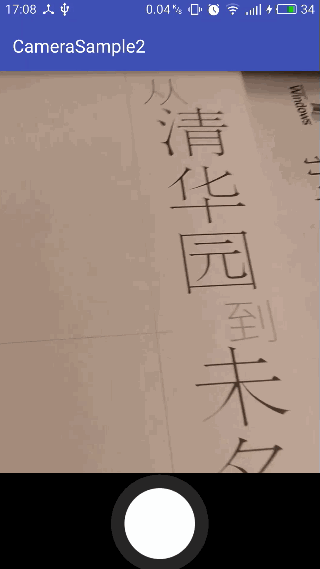
从效果图上看出,新API功能更强大,拍照效果更好。 以上两个自定义相机案例完整下载地址: https://github.com/hejunlin2013/MultiMediaSample
第一时间获得博客更新提醒,以及更多android干货,源码分析,欢迎关注我的微信公众号,扫一扫下方二维码或者长按识别二维码,即可关注。

如果你觉得好,随手点赞,也是对笔者的肯定,也可以分享此公众号给你更多的人,原创不易



